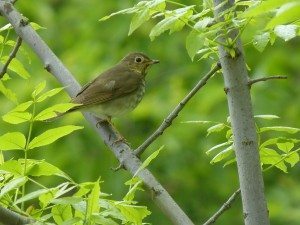The nymph Syrinx and Swainson’s Thrushes
By Burr Heneman
In his Metamorphoses, Ovid tells of a certain nymph, the most famous of all the wood nymphs. She was much beloved by the satyrs and spirits of the woods, who called her Syrinx. But she would have none of them as she was a faithful follower of chaste Diana, imitating her in her pastime of hunting, and in her virtue too.
One day as Syrinx was returning from the chase on Mount Lycaeus, Pan caught sight of her and determined to possess her. With Pan pursuing her, she fled through the pathless forest till she came to the deep waters of the Ladon River, which halted her flight. Pan reached for her, and in that instant, she prayed to her sisters of the stream to transform her.
They answered her prayer; Pan thought that he had at last caught hold of the nymph’s body but found he held only a handful of marsh reeds. As he stood sighing, the wind blew through the reeds and produced a thin, plaintive sound. “Still, you and I shall always be together,” he cried. Then he took reeds of unequal length and fastened them together with wax and made an instrument he called Syrinx and that we know as Pan pipes.

Syrinx underwent another metamorphosis centuries later when her name was given to the vocal organ of birds. The syrinx is located where the trachea divides into two bronchi, one of which leads to each lung. The name is especially apt for those few bird species that can control the two sides of the syrinx separately, creating two simultaneous tones. The result is the haunting “solo duets” of our Swainson’s Thrush and many of its relatives.
Hearing a slowed-down recording of the thrushes’ songs reveals a little of the mechanism without diminishing the magic. Here’s a web site that plays the songs at normal speed and slowed:
http://www.wildmusic.org/animals/thrush
Whenever I hear it, I am young, and Nature is in her spring; wherever I hear it, it is a new world and a free country, and the gates of Heaven are not shut against me.
Don’t count on getting more than a glimpse of the bird before it disappears into the shadows. They can be as elusive as Syrinx was for Pan.

———————–
Burr Heneman, a former executive director of PRBO – Conservation Science, currently works with two colleagues on a Galapagos Penguin conservation biology project and is a director of the Charles Darwin Research Station.
